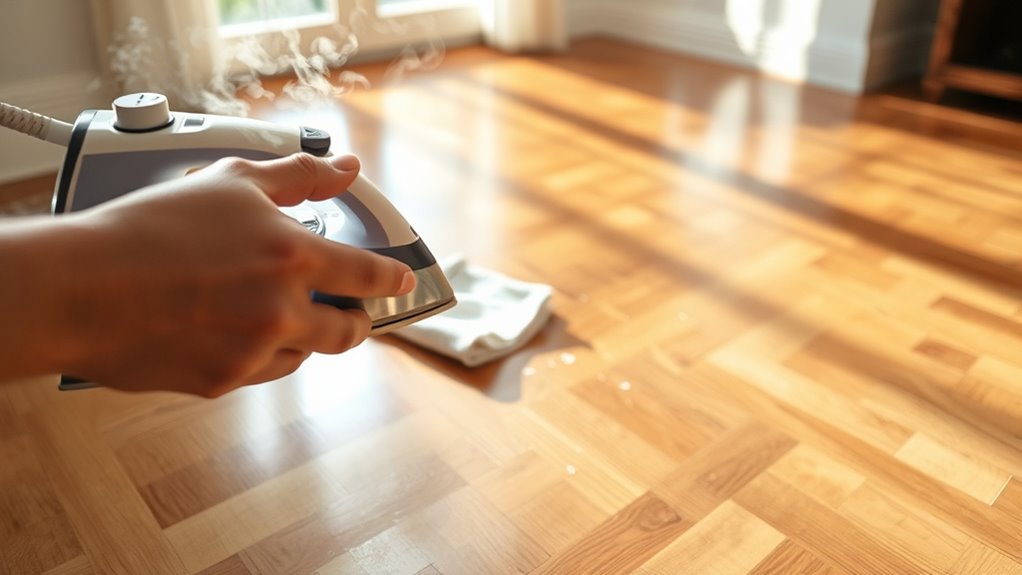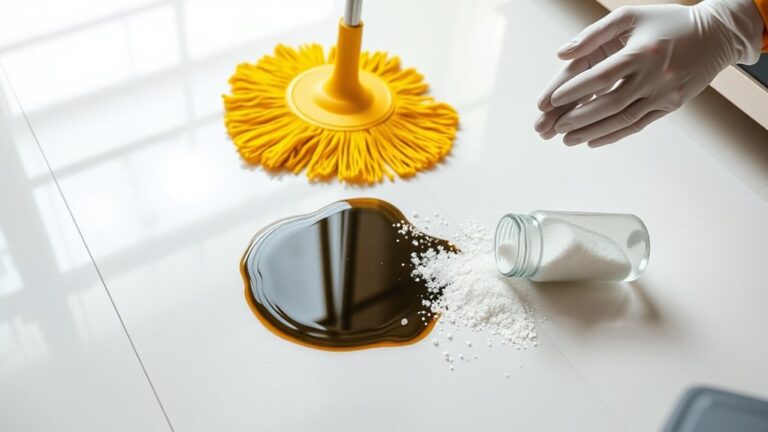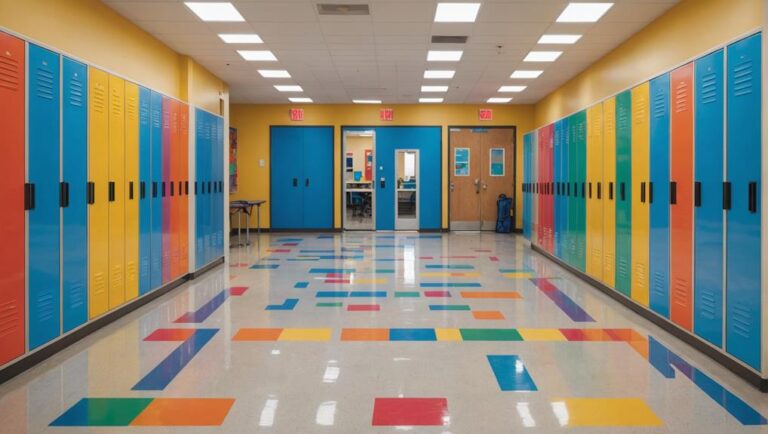To clean wax off your floor, first identify the type of wax and floor material to avoid damage. Gather a plastic scraper, soft cloths, and a suitable cleaner. Soften the wax using gentle heat from a hairdryer or a warm cloth, then carefully scrape it off with the plastic tool at a low angle. Apply a mild cleaner to remove any residue, wiping dry afterward. Following these steps will make wax removal safe and simple—explore further to master prevention and deeper cleaning methods.
Identifying the Type of Wax and Floor Material
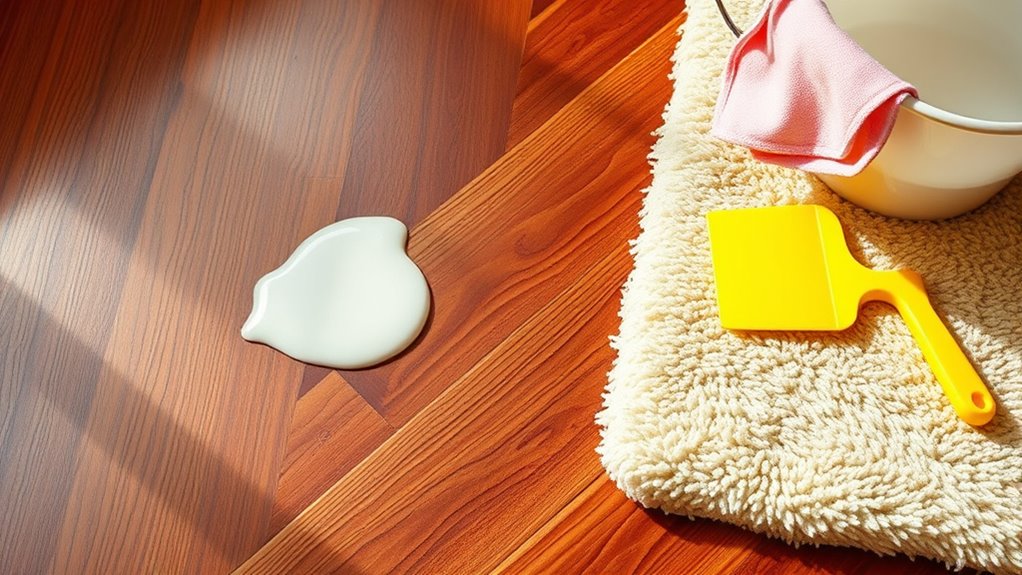
How do you determine the best method to clean wax off your floor? First, identify the wax types involved—candle wax, floor wax, or paraffin—since each reacts differently to cleaning agents. Next, recognize your floor materials: hardwood, tile, laminate, or vinyl. These surfaces demand distinct approaches to avoid damage. For instance, hardwood can be sensitive to heat and harsh chemicals, while tile withstands more aggressive methods. Understanding both wax types and floor materials guarantees you choose a technique that removes wax effectively without compromising your floor’s integrity. Take time to assess the wax’s hardness and the floor’s finish; this step sets the foundation for a cleaning process that preserves your freedom to maintain a pristine, undamaged floor.
Gathering the Necessary Tools and Supplies
Before you start removing wax from your floor, gather at least five essential tools and supplies to guarantee an efficient cleaning process. Thoughtful tool selection guarantees you work effectively without damaging your sol. Focus on having the right cleaning supplies handy to save time and effort.
Make certain you have:
- A plastic scraper or credit card to gently lift wax without scratching.
- Soft cloths or paper towels for blotting and wiping.
- A mild cleaning solution suitable for your floor type to remove residue.
These tools cover the basics, but feel free to add items like gloves or a hairdryer based on your comfort and wax type. Gathering the proper cleaning supplies upfront sets you up for a smooth, damage-free wax removal experience.
Softening the Wax for Easy Removal
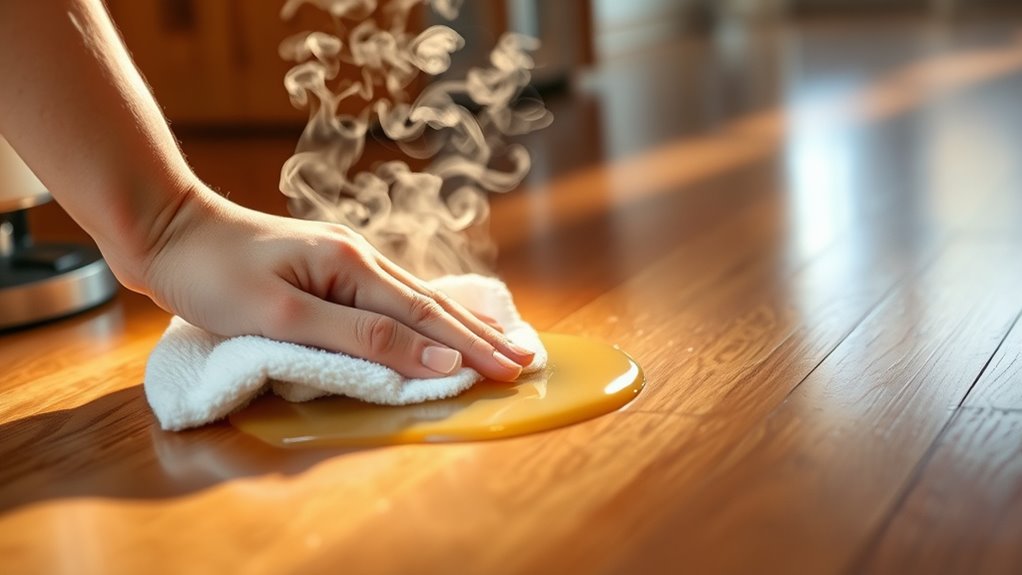
To soften the wax for easy removal, you’ll want to apply gentle heat using a hairdryer or warm cloth, which helps loosen its grip on the floor. Choose a suitable softener like mineral oil or a commercial wax remover to break down the residue effectively. Let the wax sit for a few minutes to soften before you begin scraping or wiping it away.
Use Heat Application
Although wax hardens quickly on floors, applying gentle heat can soften it, making removal much easier. You’ll want to carefully use heat sources to avoid damaging your floor while loosening the wax. Here’s how to proceed:
- Use a hairdryer on a low or medium setting, holding it a few inches above the wax to warm it gradually.
- Place a warm (not hot) cloth over the wax to soften it, allowing the heat to penetrate without direct contact.
- For stubborn wax, a heat gun on a low setting works but keep it moving to prevent burns.
Once softened, gently scrape or wipe away the wax with a plastic scraper or cloth. This heat application technique simplifies wax removal and saves you effort.
Select Suitable Softener
Choosing the right softener can make removing wax from your floor much easier and faster. Start by exploring softener options that suit your floor type and personal preferences. Commercial wax removers are effective but sometimes harsh. If you prefer natural alternatives, consider using vinegar or lemon juice diluted with water. These break down wax gently without damaging your floor’s finish. Another natural option is applying a small amount of olive oil to loosen the wax. Avoid abrasive chemicals if you want to maintain freedom from toxins. Test your chosen softener on a small, hidden spot to verify it won’t discolor or damage your floor. Selecting the appropriate softener not only speeds up the process but also preserves your floor’s integrity, giving you freedom to clean confidently and safely.
Allow Wax to Soften
Once you’ve selected the right softener for your floor, the next step is to let the wax soften properly. This is essential for effective wax removal techniques, as softened wax lifts easily without damaging your floor. To do this, apply your chosen wax softening method and allow it to sit undisturbed. Here’s how to optimize the process:
- Apply the softener evenly over the waxed area, ensuring full coverage.
- Let it sit for 10-15 minutes, or as recommended by the product instructions.
- Avoid rushing; premature scraping can spread wax or damage surfaces.
Taking this time gives the softener a chance to break down the wax’s bond, making removal smoother and preserving your floor’s finish. Patience here means freedom from stubborn wax residues later on.
Scraping Off Excess Wax Safely
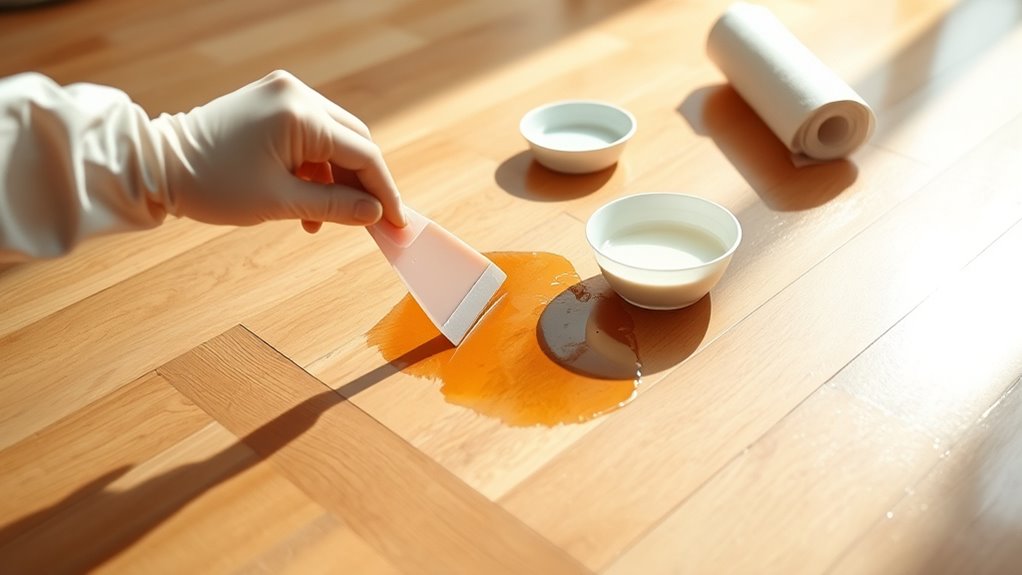
To scrape off excess wax safely, use a plastic scraper or a putty knife with a dull edge to avoid damaging your floor. Always protect the surface by working gently and keeping the tool at a low angle. Apply steady, controlled pressure to lift the wax without scratching or gouging.
Tools for Safe Scraping
Start by gathering the right tools to safely scrape off excess wax without damaging your floor. Using proper scraping tools and safe methods guarantees you maintain your floor’s integrity while freeing it from stubborn wax. Choose tools that are effective yet gentle to prevent scratches or gouges. Here are three essentials to have on hand:
- Plastic scrapers or putty knives: These provide enough edge to lift wax without harming the surface.
- Soft cloths or microfiber towels: Perfect for wiping away loosened wax residues.
- Rubber spatulas: Flexible and safe for delicate flooring types.
Avoid metal blades as they may scratch. Always test your chosen tool on a small, hidden area first. With these scraping tools and safe methods, you’ll enjoy a clean floor and the freedom to act confidently.
Protecting Floor Surfaces
Although scraping off wax might seem straightforward, protecting your floor surface during the process is essential to avoid damage. Start by placing a soft cloth or plastic sheet around the work area to catch any debris and prevent scratches. Use gentle pressure when handling tools, ensuring you don’t gouge or chip the floor. If your floor is wooden or delicate, consider applying a floor protection wax or sealant beforehand to add a barrier against potential harm. Always keep surface care in mind: avoid harsh chemicals or abrasive materials that can strip finishes or dull shine. By prioritizing floor protection and careful surface care, you maintain your floor’s integrity while removing wax effectively, giving you the freedom to enjoy a clean, undamaged space.
Proper Scraping Techniques
Begin by selecting a plastic scraper or a putty knife with a dull edge to gently lift the wax without scratching your floor. Proper scraping techniques prioritize floor safety while effectively removing excess wax. Apply these tips:
- Hold the scraper at a low angle, sliding it under the wax to avoid gouging.
- Use slow, controlled motions, peeling the wax away rather than forcing it.
- Avoid metal tools that can damage the floor’s finish and compromise safety.
Cleaning Residual Wax Stains
Even if you’ve removed most of the wax, residual stains can still linger on your floor. To tackle these, start by choosing the right cleaning products—opt for those designed for your floor type to avoid damage. Apply a small amount of the cleaning product directly to the stained area. Let it sit for a few minutes to loosen the wax residue. Then, gently scrub with a soft cloth or sponge in circular motions. Avoid abrasive tools that might scratch the surface. After the stain lifts, wipe the area with a damp cloth to remove any leftover cleaner. Finally, dry the floor thoroughly to prevent streaks or water damage. This method guarantees your floor regains its original look without compromising its finish.
Preventative Tips to Avoid Future Wax Spills
To prevent future wax spills, you’ll want to establish a few simple habits that minimize risk. Implementing wax prevention tips not only saves time but also protects your floors from damage. Focus on these key practices for effective floor care:
Adopt simple habits now to prevent wax spills and protect your floors from damage.
- Place candles or wax-based items on sturdy, heat-resistant trays or holders to catch drips and prevent direct contact with the floor.
- Keep wax items away from high-traffic areas where accidental bumps are more likely, reducing the chance of spills.
- Store wax products securely when not in use, preferably in closed containers or cabinets, to avoid unintentional tipping or melting in warm spots.

